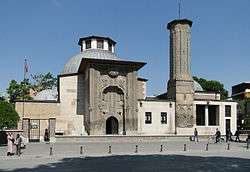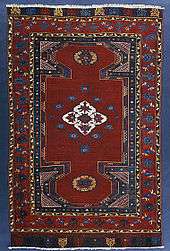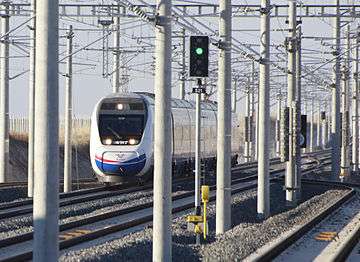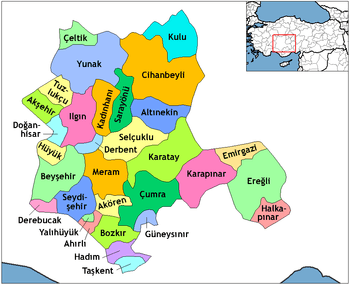Konya
| Konya | |
|---|---|
| City | |
|
Mevlana Museum (1274) is the resting place of the Sufi mystic and poet Rumi in Konya, the capital of the Anatolian Seljuk Sultanate. | |
 Konya Location of Konya, Turkey | |
| Coordinates: 37°52′N 32°29′E / 37.867°N 32.483°ECoordinates: 37°52′N 32°29′E / 37.867°N 32.483°E | |
| Country |
|
| Region | Central Anatolia |
| Province | Konya |
| Government | |
| • Mayor | Tahir Akyürek (AKP) |
| Area | |
| • Total | 38,873 km2 (15,009 sq mi) |
| Elevation | 1,200 m (3,900 ft) |
| Population (2014)[1] | |
| • Total | 1,220,795 |
| • Density | 50/km2 (100/sq mi) |
| Time zone | EET (UTC+2) |
| • Summer (DST) | EEST (UTC+3) |
| Postal code | 42XXX |
| Area code(s) | (+90) 332 |
| Licence plate | 42 |
| Website | www.konya.bel.tr |
Konya (Turkish pronunciation: [ˈkon.ja]; Greek: Ἰκόνιον Ikónion, Latin: Iconium) is a major city in the Central Anatolia Region of Turkey. It is the seventh most populous city in Turkey. As of 2014, Konya has a population of 1,174,536.[1] Konya is an economically and industrially developed city [2][3][4] and the capital of Konya Province.
Konya was historically the capital of the Seljuk Sultanate of Rum (Anatolia) and the Karamanids.
Name
Konya, was known in classical antiquity and during the medieval period as Ἰκόνιον (Ikónion) in Greek (with regular Medieval Greek apheresis Kónio(n)) and as Iconium in Latin. This name is commonly explained as a derivation from εἰκών (icon), as an ancient Greek legend ascribed its name to the "eikon" (image), or the "gorgon's (Medusa's) head", with which Perseus vanquished the native population before founding the city.[5] In some historic English texts, the city's name appears as Konia or Koniah.
History
Ancient history
.jpg)
Excavations have shown that the region was inhabited during the Late Copper Age, around 3000 BC.[5] The city came under the influence of the Hittites around 1500 BC. These were overtaken by the Sea Peoples around 1200 BC.
The Phrygians established their kingdom in central Anatolia in the 8th century BC. Xenophon describes Iconium, as the city was called, as the last city of Phrygia. The region was overwhelmed by Cimmerian invaders c. 690 BC. It was later part of the Persian Empire, until Darius III was defeated by Alexander the Great in 333 BC.
Alexander's empire broke up shortly after his death and the town came under the rule of Seleucus I Nicator. During the Hellenistic period the town was ruled by the kings of Pergamon. As Attalus III, the last king of Pergamon, was about to die without an heir, he bequeathed his kingdom to the Roman Republic. During the Roman Empire, under the rule of emperor Claudius, the city's name was changed to Claudioconium, and during the rule of emperor Hadrianus to Colonia Aelia Hadriana.
The apostles Paul and Barnabas preached in Iconium during their first Missionary Journey in about 47–48 AD (see Acts 13:51, Acts 14:1–5 and Acts 14:21), having been persecuted in Antioch, and Paul and Silas probably visited it again during Paul's Second Missionary Journey in about 50 (see Acts 16:2).[6] Their visit to the synagogue of the Jews in Iconium divided the Jewish and non-Jewish communities between those who believed Paul and Barnabas' message and those who did not believe, provoking a disturbance during which attempts were made to stone the apostles. They fled to Lystra and Derbe, cities of Lycaonia. Paul recalled this experience in his second letter to Timothy (Acts 14:1–5), Albert Barnes therefore suggesting that Timothy had been present with Paul in Iconium, Antioch and Lystra.[7] The city became the seat of a bishop, which in ca. 370 was raised to the status of a metropolitan see for Lycaonia, with Saint Amphilochius as the first metropolitan bishop.[8]
In Christian legend, based on the apocryphal Acts of Paul and Thecla, Iconium was also the birthplace of Saint Thecla, who saved the city from attack by the Isaurians.[8]
Under the Byzantine Empire, the city was part of the Anatolic Theme. During the 8th–10th centuries, the town and the nearby Kabala (Caballa) Fortress (Turkish: Gevale Kalesi) were a frequent target of Arab attacks as part of the Arab–Byzantine wars.[8]
Seljuk era

The Seljuk Turks first raided the area in 1069, but a period of chaos overwhelmed Anatolia after the Seljuk victory in the Battle of Manzikert in 1071, and the Norman mercenary leader Roussel de Bailleul rose in revolt at Iconium. The city was finally conquered by the Seljuks in 1084.[8] From 1097 to 1243 it was the capital of the Seljuk Sultanate of Rum. It was briefly occupied by the Crusaders Godfrey of Bouillon (August 1097), and Frederick Barbarossa (May 18, 1190) after the Battle of Iconium (1190). The area was retaken by the Turks.
The name of the town was changed to Konya (in Persian: قونیه quniya) by Mesud I in 1134.

Konya reached the height of its wealth and influence in the second half of the 12th century when the Seljuk sultans of Rum also subdued the Anatolian beyliks to their east, especially that of the Danishmends, thus establishing their rule over virtually all of eastern Anatolia, as well as acquiring several port towns along the Mediterranean (including Alanya) and the Black Sea (including Sinop) and even gaining a momentary foothold in Sudak, Crimea. This golden age lasted until the first decades of the 13th century.
Many Persians and Persianized Turks from Persia and Central Asia migrated to Anatolian cities either to flee the invading Mongols or to benefit from the opportunities for educated Muslims in a newly established kingdom.[9] By the 1220s, the city of Konya was filled with refugees from the Khwarezmid Empire. Sultan Kayqubad I fortified the town and built a palace on top of the citadel. In 1228 he invited Bahaeddin Veled and his son Rumi, the founder of the Mevlevi order, to settle in Konya.
In 1243, following the Seljuk defeat in the Battle of Köse Dağ, Konya was captured by the Mongols as well. The city remained the capital of the Seljuk sultans, vassalized to the Ilkhanate until the end of the century.
In this era (13th century) Persian was the main language of people of Konya.[10][11] Persian refugees fled the Mongols to Konya. One of these refugees was Persian poet Rumi. The city is still influenced by Persian culture, such as Cult of Dervishes and Islamic mysticism rooted in eastern Iran.[12]
Karamanid era
Following the fall of the Anatolian Seljuk Sultanate in 1307, Konya was made the capital of a Turkish beylik (emirate); which lasted until 1322 when the city was captured by the neighbouring Beylik of Karamanoğlu. In 1420, the Beylik of Karamanoğlu fell to the Ottoman Empire and, in 1453, Konya was made the provincial capital of Karaman Eyalet.
Ottoman era

During Ottoman rule, Konya was administered by the Sultan's sons (Şehzade), starting with Şehzade Mustafa and Şehzade Cem (the sons of Sultan Mehmed II), and later the future Sultan Selim II. Between 1483 and 1864, Konya was the administrative capital of Karaman Eyalet. During the Tanzimat period, as part of the vilayet system introduced in 1864, Konya became the seat of the larger Vilayet of Konya which replaced Karaman Eyalet.
Turkish War of Independence
Konya had a major air base during the Turkish War of Independence. In 1922, the Air Force was renamed as the Inspectorate of Air Forces[13] and was headquartered in Konya.[14][15] The Third Air Wing[16] of the 1st Air Force Command[17] is based at the Konya Air Base. The wing controls the four Boeing 737 AEW&C Peace Eagle aircraft of the Turkish Air Force.[18][19]
Republic era
Konya was a center for agriculture at the turn of the 20th century. Since the late 20th century, the economy has diversified.
The Meram highway was constructed in 1950.
The first Konya National Exhibition and Fair was held in 1968.
The Koyunoğlu Museum was donated to the city in 1973 and it reopened in a new building.
Government
The first local administration in Konya was founded in 1830. This administration was converted into a municipality in 1876.[20] In March 1989, the municipality became a Metropolitan Municipality. As of that date, Konya had three central district municipalities (Meram, Selçuklu, Karatay) and a Metropolitan Municipality.
Geography
Konya is the center of the largest province, and is among the largest cities in the country. It is the seventh most populated city in Turkey.[21]
Konya City is in the southern part of the Middle Anatolian Region. The land is broad and flat with a lot of lowlands and plateaus. The plateaus are covered with rich steppes, therefore, affecting the agriculture sector. Additionally, the southernmost part of Konya is largely surrounded by the Taurus mountain range.
Lakes:
Lake Tuz, traditionally known as Tuz Golu, is the second largest lake in all of Turkey. This lake supplies Turkey with a large amount of Turkey's salt demand
Beysehir Lake is on the western part of Konya and is near the border. It is known to be the largest fresh water late in Turkey and one of the most important national parks. Beysehir Lake is important for tourism in Konya and attracts thousands of people each year to its 2 beaches and 22 islands for water and mountain sports.
Meke Lake is on the border of the Karapinar province and is considered to be a heavily protected natural area.
Climate
Konya has a cold semi-arid climate (BSk) under the Köppen classification[22] and a hot summer continental (Dca) or hot summer oceanic (Doa) climate under the Trewartha classification.
Summers temperatures average 30 °C (86 °F). The highest temperature recorded in Konya was 40.6 °C (105 °F) on 30 July 2000. Winters average −4.2 °C (24 °F). The lowest temperature recorded was −26.5 °C (−16 °F) on 6 February 1972. Due to Konya's high altitude and its dry summers, nightly temperatures in the summer months are cool. Precipitation levels are low, but precipitation can be observed throughout the year.
| Climate data for Konya (1950 - 2014) | |||||||||||||
|---|---|---|---|---|---|---|---|---|---|---|---|---|---|
| Month | Jan | Feb | Mar | Apr | May | Jun | Jul | Aug | Sep | Oct | Nov | Dec | Year |
| Record high °C (°F) | 17.6 (63.7) |
23.8 (74.8) |
28.9 (84) |
31.5 (88.7) |
34.4 (93.9) |
37.2 (99) |
40.6 (105.1) |
39.6 (103.3) |
36.1 (97) |
31.6 (88.9) |
25.2 (77.4) |
21.8 (71.2) |
40.6 (105.1) |
| Average high °C (°F) | 4.8 (40.6) |
7.1 (44.8) |
11.9 (53.4) |
17.5 (63.5) |
22.3 (72.1) |
26.7 (80.1) |
30.2 (86.4) |
30.1 (86.2) |
26.0 (78.8) |
19.8 (67.6) |
12.9 (55.2) |
6.6 (43.9) |
17.99 (64.38) |
| Daily mean °C (°F) | 0.0 (32) |
1.4 (34.5) |
5.7 (42.3) |
11.1 (52) |
15.7 (60.3) |
20.2 (68.4) |
23.6 (74.5) |
23.1 (73.6) |
18.6 (65.5) |
12.4 (54.3) |
6.1 (43) |
1.7 (35.1) |
11.63 (52.96) |
| Average low °C (°F) | −3.9 (25) |
−3.2 (26.2) |
0.0 (32) |
4.5 (40.1) |
8.7 (47.7) |
12.8 (55) |
16.1 (61) |
15.7 (60.3) |
11.1 (52) |
6.0 (42.8) |
0.8 (33.4) |
−2.3 (27.9) |
5.53 (41.95) |
| Record low °C (°F) | −25.8 (−14.4) |
−26.5 (−15.7) |
−15.8 (3.6) |
−8.6 (16.5) |
−1.2 (29.8) |
3.2 (37.8) |
6.0 (42.8) |
6.6 (43.9) |
0.4 (32.7) |
−7.6 (18.3) |
−20.0 (−4) |
−22.4 (−8.3) |
−26.5 (−15.7) |
| Average precipitation mm (inches) | 35.9 (1.413) |
28.0 (1.102) |
27.5 (1.083) |
32.3 (1.272) |
43.3 (1.705) |
24.3 (0.957) |
6.6 (0.26) |
5.3 (0.209) |
11.8 (0.465) |
30.1 (1.185) |
32.6 (1.283) |
42.0 (1.654) |
319.7 (12.588) |
| Average precipitation days | 9.8 | 8.6 | 8.9 | 9.4 | 10.8 | 6.7 | 2.3 | 1.5 | 3.1 | 6.3 | 6.8 | 9.9 | 84.1 |
| Mean monthly sunshine hours | 99.2 | 124.3 | 207.7 | 213.0 | 279.0 | 312.0 | 353.4 | 347.2 | 282.0 | 223.2 | 156.0 | 96.1 | 2,693.1 |
| Percent possible sunshine | 32.6 | 40.9 | 56.2 | 53.9 | 63.3 | 70.4 | 78.5 | 82.3 | 75.7 | 64.2 | 51.4 | 32.5 | 58.49 |
| Source: Turkish State Meteorological Service[23] | |||||||||||||
Education


Konya hosts the Tactical Training Center Anatolian Eagle, a center for training NATO Allies and friendly Air Forces. Real Like training environment with large area and skilled aggressors provides a training opportunity to reach the maximum combat readiness for Air Force Fighters. Official Web Site
Konya ranks among the nation's top 10 cities for the average score of high school graduates. There are various elementary and secondary schools in the province. The Meram Fen Lisesi is among Turkey's first-tier science high schools.
Konya is one of the few cities to contain more than 100,000 college students. Selçuk University had the largest number of students, 76,080, of any public university in Turkey during the 2008-09 academic year.[24] It was founded in 1975. The other public university is Necmettin Erbakan University which was established in Konya in 2010.[25]
Private colleges in Konya include the KTO Karatay University and Mevlana University.[26][27]
Economy
The city ranks among the Anatolian Tigers.[2][3][4] There are a number of industrial parks.[28] In 2012 Konya's exports reached 130 countries.[28] A number of Turkish industrial conglomerates, such as Kombassan Holding, have their headquarters in Konya.[29]
While agriculture-based industries play a role, the city's economy has evolved into a center for the manufacturing of components for the automotive industry; machinery manufacturing; agricultural tools; casting industry; plastic paint and chemical industry; construction materials; paper and packing industry; processed foods; textiles; and leather industry.[28]
Transportation


Bus
The bus station has connections to a range of destinations, including Istanbul, Ankara and İzmir.
Tram
Konya has a tramway network in the city center, on which the Škoda 28 T trams are being used.[30]
Railway
Konya is connected to Ankara, Eskişehir and Istanbul via the high-speed railway services of the Turkish State Railways.[31][32]
Airport
Konya Airport is a public airport and military airbase that is also used by NATO. In 2006, Konya Airport served 2,924 aircraft and 262,561 passengers.[33]
Notable people
- Tertius of Iconium, the amanuensis who wrote down Paul the Apostle's Epistle to the Romans
- Sadr al-Din al-Qunawi disciple of Ibn Arabi and an original thinker in his own right.
- Jalal al-Din Muhammad Rumi, also called Mawlana Balkhi or "Mevlâna", was the founder of the Sufi Mevlevi order (known for the Whirling Dervishes). He spent the last fifty years of his life in Konya. His tomb is located here.
- Orkut Büyükkökten, a software engineer who developed the social networking service Orkut, was born in 1975 in Konya.[34]
- Mehmet Oz (Dr. Oz), famous television doctor appearing on US television.
Main sights
- Mevlana Museum, formerly the tekke of Mevlana
- Sille. 8 kilometres (5.0 miles) northwest from Mevlana Museum. Antique village. mosques, churches, cave churches and catakombs on the historic Kings Road - Silky Road - Pilgrims Road to Jerusalem. Sillehan, a must see in Konya.
- Alâeddin Mosque
- Ince Minaret Medrese—Museum
- Karatay Medrese—Museum
- Aziziye Mosque
- Konya Ethnography Museum
- Konya Archaeological Museum[35]
- Atatürk's House Museum
- İzzet Koyunoğlu City Museum
- St. Paul's Catholic Church—at Alaeddin Hill
- Seljuk Tower, the tallest building in Konya
Culture

Konya was the final home of Rumi (Mevlana), whose tomb is in the city. In 1273, his followers in Konya established the Mevlevi Sufi order of Islam and became known as the Whirling Dervishes. Konya has the reputation of being one of the more religiously conservative metropolitan centers in Turkey. It was once known as the "citadel of Islam" and its inhabitants are still comparatively more devout than those from other cities.[36]
Konya produced Turkish carpets that were exported to Europe during the Renaissance.[37][38] These expensive, richly patterned textiles were draped over tables, beds, or chests to proclaim the wealth and status of their owners, and were often included in the contemporary oil paintings as symbols of the wealth of the painter's clients.[39]
A Turkish folk song is named "Konyalım", making reference to a loved one from Konya.[40]
The local cuisine of Konya includes dishes made of bulgur wheat and lamb meat.[41] One of the renowned dishes of the city is etli ekmek, which is similar to lahmacun and pizza.[41]
Food:
Etliekmek- flat bread baked with ground meat, peppers, onions, and tomatoes
Pişmaniye- similar to American cotton candy and resembles a fully white ball of yarn
Firun Kebab- over-cooked meat (usually lamb)
Various Candies: Konya is known for their sweets. They are famous for Cezerye, an old Turkish sweet made of carrots.
Tirit- a traditional rice dish that is made with meat and various vegetables.
Tavak Suyu- a tomato broth based soup made with shredded chicken and noodles
Twin towns
Konya is twinned with:
|
Europe |
Americas
|
West Asia |
Other parts of Asia |
See also
Further reading
- Published in the 19th century
- "Konia", Handbook for Travellers in Turkey (3rd ed.), London: J. Murray, 1854, OCLC 2145740
- Clément Huart (1897). Konia, la ville des derviches tourneurs (in French). Paris: Leroux.
- Published in the 20th century
- "Konia", The Encyclopaedia Britannica (11th ed.), New York: Encyclopaedia Britannica, 1910, OCLC 14782424
- E. Broadrup (1995). "Konya/Catal Huyuk". International Dictionary of Historic Places. Chicago: Fitzroy Dearborn.
- Published in the 21st century
- C. Edmund Bosworth, ed. (2007). "Konya". Historic Cities of the Islamic World. Leiden: Koninklijke Brill.
- "Konya". Grove Encyclopedia of Islamic Art & Architecture. Oxford University Press. 2009.
Sources
- General
- "About Konya/ Geography and Transportation". Konya Sanayi Odasi. Retrieved November 12, 2016.
- Gould, Kevin. "Konya, In a Whirl of its Own". The Guardian. Retrieved November 12, 2016.
- "7 Good Eats in Konya". My Traveling Joys. Retrieved November 12, 2016.
- References and notes
- 1 2 "Turkey: Major cities and provinces". citypopulation.de. Retrieved 2015-02-08.
- 1 2 Financial Times: Reports — Anatolian tigers: Regions prove plentiful
- 1 2 root. "Anatolian Tigers". Investopedia. Retrieved 25 May 2015.
- 1 2 Zaman: Anatolian tigers conquering the world
- 1 2 "Konya". Encyclopædia Britannica. Retrieved 25 May 2015.
- ↑ see William Ramsay, Cities of St. Paul, 315–384; F. F. Bruce, Paul: Apostle of the Heart Set Free Grand Rapids, MI: Eerdmans, 1977. p. 475.
- ↑ Barnes, A, Barnes' Notes on the Bible http://biblehub.com/commentaries/barnes/acts/14.htm accessed 6 September 2015
- 1 2 3 4 Foss, Clive (1991). "Ikonion". In Kazhdan, Alexander. Oxford Dictionary of Byzantium. London and New York: Oxford University Press. p. 985. ISBN 978-0-19-504652-6.
- ↑ Mango, Andrew, Discovering Turkey, Hastings House, 1972, page 61
- ↑ همایی، جلال الدین: مولوی نامه/مولوی چه میگوید؟ (مجموعه دو جلدی). صفحه 1004: ".. زبان فارسی چندان رواج و شیوع داشت که در حکم زبان بومی شمرده میشد و همگان آن را درمیافتند و فهم میکردند. بهترین دلیل ما بر این دعوی گفتهٔ سلطان ولد فرزند برومند مولوی که است که در همان قونیه متولد شده و همانجا نشو و نما یافته و آثار ادبی خود را بوجود آورده بود. وی در منظومهٔ ولدنامه بعد از چندبیت که بعربی ساخته است میگوید: فارسی گو که جمله دریابند. گرچه زین غافلاند و در خوابند
- ↑ «فارسی، زبان مردم کوچه بازار قونیه بوده است». سایت خبری ایران بالکان. بایگانیشده از نسخهٔ اصلی در ۲۶ ژانویه ۲۰۱۳. بازبینیشده در ۳۰ خرداد ۱۳۸۹.
- ↑ fa:قونیه
- ↑ Turkic:Kuva-yı Havaiye Müfettişliği
- ↑ "Bir Hata Oluştu". Retrieved 25 May 2015.
- ↑ Utkan Kocatürk, Atatürk ve Türkiye Cumhuriyeti tarihi kronolojisi, 1918-1938, Türk Tarîh Kurumu Basımevi, 1983, p. 674.
- ↑ Ana Jet Üssü or AJÜ
- ↑ Hava Kuvvet Komutanlığı
- ↑ Mehmet Kayhan YILDIZ- Hasan BÖLÜKBAŞ- Serdar ÖZGÜR- Tolga YANIK- Hasan DÖNMEZ/ KONYA,(DHA). "TSK yeni yıldızı Barış Kartalı'na kavuştu". HÜRRİYET - TÜRKİYE'NİN AÇILIŞ SAYFASI. Retrieved 25 May 2015.
- ↑ "Turkey takes delivery of military aircraft". TodaysZaman. Archived from the original on February 22, 2015. Retrieved 25 May 2015.
- ↑ " İhtisab Agalıgi" (Islamic-Ottoman office for public regularity)
- ↑ http://www.citypopulation.de/Turkey-RBC20.html December 2012 address-based calculation of the Turkish Statistical Institute as presented by citypopulation.de
- ↑ Updated world map of the Köppen-Geiger climate classification - Hydrology and Earth System Sciences Discussions
- ↑ "Meteoroloji" (in Turkish). Retrieved 8 January 2016.
- ↑ About Turkey and Konya, Konya Livestock Congress, 2014
- ↑ "Konya Necmettin Erbakan Üniversitesi". Retrieved 25 May 2015.
- ↑ "KTO Karatay Üniversitesi". Karatay.edu.tr. Retrieved 2011-09-16.
- ↑ A Fuat Mercan. "Mevlana Üniversitesi | Mevlana University". Mevlana.edu.tr. Retrieved 2011-09-16.
- 1 2 3 "General Overview Of The Konya Economy". Retrieved 25 May 2015.
- ↑ "History « Kombassan Holding". Retrieved 25 May 2015.
- ↑ (English) "Škoda Transportation wins Konya tram contract". Retrieved 2013-09-05.
- ↑ "Opening of Ankara - Konya fast line completes strategic link". Railway Gazette. 24 August 2011. Retrieved 2013-02-12.
- ↑ "Invensys commissions ERTMS solution on Turkish High Speed Line". European Railway Review. 7 September 2011. Archived from the original on 19 December 2011. Retrieved 20 December 2011.
- ↑ (Turkish) Konya Hava Meydanı at DHMİ (State Airports Authority)
- ↑ "Introduction to Orkut". Retrieved 25 May 2015.
- ↑
- ↑ "BBC NEWS - Europe - 'Islam problem' baffles Turkey". Retrieved 25 May 2015.
- ↑ King, Donald and Sylvester, David. The Eastern Carpet in the Western World, From the 15th to the 17th century, Arts Council of Great Britain, London, 1983, ISBN 0-7287-0362-9. pp. 26-27, 52-57.
- ↑ Campbell, Gordon. The Grove Encyclopedia of Decorative Arts, Volume 1, "Carpet, S 2; History (pp. 187–193), Oxford University Press US, 2006, ISBN 0-19-518948-5, ISBN 978-0-19-518948-3 Google books. p. 189.
- ↑ "oldturkishcarpets.com". Retrieved 25 May 2015.
- ↑ "Konyalım". Retrieved 25 May 2015.
- 1 2 "Konya Büyükşehir Belediyesi". Retrieved 25 May 2015.
- ↑ Kyoto İle Kardeş Şehir Protokolü İmzalandı, Heyet Japon Parkı'nı Gezdi, Konya Büyükşehir Belediyesi (2010)
- 1 2 "Rumi Remembered in Birthplace of Shams". Retrieved 21 March 2015.
External links
| Wikimedia Commons has media related to Konya. |
| Wikisource has the text of the 1911 Encyclopædia Britannica article Konia. |
 Konya travel guide from Wikivoyage
Konya travel guide from Wikivoyage- Encyclopædia Britannica: Konya
- More information about Konya
- Emporis: Database of highrises and other structures in Konya
- Detailed Pictures of Mevlana Museum
- Pictures of the city, including Mevlana Museum and several Seljuk buildings
- 600 Pictures of the city and sights
- Extensive collection of pictures of the Mevlana museum in Konya
- Cities of St. Paul, 316-384
- ArchNet.org. "Konya". Cambridge, Massachusetts, USA: MIT School of Architecture and Planning.
- "Konya". Islamic Cultural Heritage Database. Istanbul: Organization of Islamic Cooperation, Research Centre for Islamic History, Art and Culture. Archived from the original on May 16, 2013.

